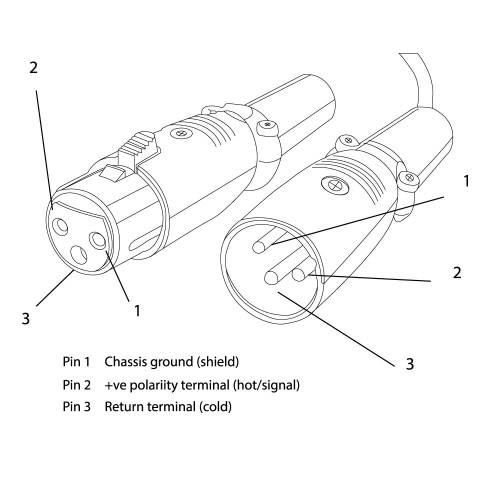An XLR connector is a type of electrical connector that is mainly found on different types of audio, video, as well as stage lighting equipment at present. Being circular in design, these connectors consist of anything between 3 to 7 pins. In most cases, these audio connector types are related to balanced audio interconnection which includes AES3 audio; apart from this, they are likewise utilized for low-voltage power supplies, lighting control, along with other applications. You will come across different manufacturers who are known to produce these XLR connectors, and these connectors are usually covered by IEC 61076-2-103, which happens to be a global standard for measurements. Although superficially identical to the more compact and older DIN connector range, these are not compatible with them physically.
Definition
XLR connectors were invented originally by an individual whose name was James Cannon who also founded Cannon Electric ( later purchased by ITT). For this reason, sometimes several veterans refer to these connectors as “Cannon Plugs”. This innovative plug was branded by Cannon Electric as the Cannon X-Series. A model was added by them afterward which consisted of a latch to lock the cables together, and this was known as the Canon XL. Eventually, a model along with a durable and robust rubber compound encircling the female XLR socket was produced which was known as the Cannon XLR connector. Consequently, the term XLR stands for Cannon X-Series connector with Latch and Rubber.
1) Balanced cables
At present, we make use of XLR cables in different types of audio applications which range from professional recording sessions to even live performances. These cables consist of a circular connector as well as three pins which help in producing a balanced microphone plus line-level signals over a long distance. The ability of an XLR cable to produce a balanced signal implies that reduced unwanted noise is going to be received by the eventual audio signal from any external electrical interference. In this way, the original audio signal is going to be preserved even in the close vicinity of other electronic gadgets over a long distance.
2) 3-Pin Wiring – Male/Female Type
These days, the XLR connectors can be obtained in both female as well as male versions in cable as well as chassis mounting layouts – a total of as many as four styles. However, this is a bit unusual given that one of these styles has been omitted by quite a few connector designs (usually a male chassis mounting connector). See the 3-pin xlr pinout diagram below.
On the contrary, the female connectors have been designed to connect pin 1 initially (the earth pin) before contact is made by the other pins once the male connector has been inserted. With the establishment of the ground connection before the connection on the signal lines, the insertion, as well as removal of the XLR connectors in a live device, is feasible without any need to pick up outside signals (as usually takes place with RCA connectors, for instance).
The number of pins is going to differ. These connectors are obtainable with as many as ten pins, and the mini connectors with as many as eight pins. Excepting the Switchcraft six-pin models that use non-regular management for the pins, the 3-pin XLR connectors produced by various manufacturers are going to intermate.
On a typical 3-pin XLR connector, the 3 pins are the chassis/ground or shield, the positive hot signal terminal, and the return/cold terminal. If you have some soldering iron skills, you can make up your own balanced cables. I recommend using Neutrik brand connectors for making your own instrument or microphone cables. Remember to double-check check you have your positive and negative wires the right way around. You can also make up your own XLR panel mount sockets for installation on a wall or floor.
How to wire an XLR plug
(pinout diagram)

(Feel free to use this pinout image, but please add an attribute on your website pointing back to the page, using just the URL, my name, or the name of my website. Also, feel free to pin on Pinterest if you wish.)
If you would like to share this post you can copy this link and then paste on social media or your blog –
https://churchsoundtips.com/xlr-con/
3) Audio cable for sound desks:
Now that we know what an XLR port is, let us throw some light on cabling for sound desks.
The unbalanced audio cables consist of a couple of wires which function as conductors; one responsible for carrying both the ground as well as the signal. Despite being comparatively pricey, these are vulnerable to any noise produced by the interference from the electrical fields of any nearby electronic gadget. Because of this, the usage of unbalanced cables is not recommended for all applications that need long cables. The recommended length for the balanced cables is 25 feet to 30 feet at present. For these kinds of lengths, it is recommended to use some form of ‘snake cable’ as it is commonly called, which is a long multicore cable with 3-pin XLR connections at both ends. You can also get a digital audio cable to connect to a digital mixer. There are several brands that make them, including Amphenol xlr connectors, which are a good make.
Balanced Cable
There are as many as three wires that come with the balanced audio cables which function as conductors, namely, negative, positive, as well as ground. The audio signal is carried by both the positive as well as negative wires having opposite polarities. This implies that any noise resulting from any external interference source is going to be nullified. Audio applications requiring long lengths over 25 to 30 feet will find these balanced cables to be ideal for them.
The XLR cables happen to be balanced cables that have circular connectors along with as many as three pins – positive, negative, as well as ground. In essence, they are almost identical to a TRS (Tip Ring Sleeve) cable. However, there is one significant difference which is that these cables appear similar to standard-jack cables. The ground signal is always the “Pin 1” (the pin which is found on the left side while facing the male connector or the hole which is found on the right side while facing the female connector).
How do XLR connections work?
A positive audio signal along with a ground signal plus a negative audio signal will be delivered by the XLR cable once 2 balanced devices are connected. Apart from being inverted, both the positive as well as negative audio signals are similar to each other. In case of any electrical interference, that noise enters both the negative audio signal as well as the positive audio signal. Once both signals reach the balanced gadget at the chain’s end, one audio signal is going to be inverted. However, these two signals are similar to one another in every possible way. Nevertheless, the noise that was on the audio signal is now inverted. These are going to cancel out one another once the original noise is combined with the inverted noise. In that case, only the original audio signal is going to be left.
4) Microphone cables
Low impedance microphones typically utilise the standard 3-pin xlr for both the connection to the mic itself and for connecting to mic inputs on a mixing desk or other audio equipment. Apart from recording instruments and other audio sources impeccably, the low-impedance microphones are excellent for podcasting as well as voice recording as well.
Being less sensitive as compared to the condensers, the dynamic microphones are an automatic choice while recording more than one individual in the same room or in case you lack a tranquil recording area. Moreover, you need to be extremely close to the microphone as well. Dynamic microphones are usually used by live performers to avoid picking up any other instrument while performing.
On the contrary, being more precise and sensitive, the condenser microphones will prove to be helpful while recording solo in a quiet ambiance. These microphones need external power which comes with the majority of the top-quality digital audio interfaces at present. Check out my other post on how to choose a microphone for singing, also my post about the best choir microphones.
5) Jack Adapters:
It is a fact that balanced audio is imperative for professional applications given that it helps to eliminate any automatic signal noise which might spoil the audio that is being produced. High-quality 3-pin XLR connectors, as well as adapters, are also vital to the process since they play a pivotal role in bringing balanced audio in and out of the microphones and other components. You will come across a wide variety of XLR connector adapters out there that facilitate male-to-female plus male-to-male XLR connections apart from connections with stereo and mono jacks and plugs. It is very important to have the appropriate 3-pin XLR adapter within reach which can prove to be extremely useful to us.
Considerations:
A balanced signal can only be delivered by the XLR cables in case both gadgets on each end of the signal are likewise balanced. Any unbalanced audio device is going to cause the entire signal chain to become unbalanced. Furthermore, it will be prudent to always verify with the manufacturer to make sure that a gadget is balanced.
Sources:
https://en.wikipedia.org/wiki/XLR_connector

Leave a Reply